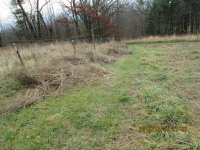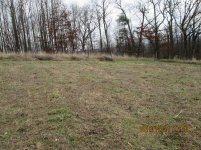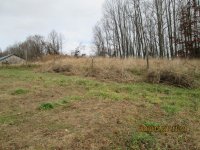You are using an out of date browser. It may not display this or other websites correctly.
You should upgrade or use an alternative browser.
You should upgrade or use an alternative browser.
a burning question
- Thread starter randy41
- Start date
/ a burning question
#1
Western
Super Member
Why risk it, there would be a chance the roots get dry I would think, but that depends on the size of fire I guess. Burn next to the row and rake it up after it cools if you're looking for the potash.
MikeInEburg
Veteran Member
I think burning on top of asparagus patch will destroy the patch. Where I burn, nothing grows naturally for years. What the heat doesn't destroy, the acidity will.
TomSeller
Super Member
I can't imagine that the burning is not going to kill the roots. When I do burn in a pasture or annual garden, I always rototill and spread out the ash as much as I can, otherwise like was mentioned, nothing will grow there for 2-3 years. If I am in a pasture, I then re-seed after rototilling to mix in soil that was not burned.
jinman
Rest in Peace
- Joined
- Feb 23, 2001
- Messages
- 21,008
- Location
- Texas - Wise County - Sunset
- Tractor
- NHTC45D, NH LB75B, Ford Jubilee
I believe the reason you don't see much growing after burning is that the seeds from weeds and some grasses may be burned by the fire since they are also on top of the ground. Burning wipes out weeds while allowing fresh grass growth from established roots below ground. I think burning will produce very little effect on your asparagus crowns that should be 4"-6" deep in the ground. People even spread salt lightly on the surface to kill weeds and inhibit germination of noxious plant seeds. I see burned areas in the medians of highways that rapidly sprout grasses and look better than any surrounding unburned area. Even forests get prescribed burns to kill off undergrowth and encourage new growth of grasses and tree seedlings.
Also, asparagus beds are very tolerant of light salt treatment. The salt treatment will kill off any seedlings, though. What you may find with the asparagus, if burned, is that you have very few seedlings coming up "volunteer." I have thousands of asparagus plants coming up every year from the seeds that are broadcast over the ground. By letting them grow and adding compost to the beds each year, I assure myself of ever-increasing asparagus beds. I really think your best solution will be to shred your beds using your rotary cutter or mower so that the seeds and tops are spread around over the area and decompose rapidly and naturally. The mature canes will lay there for years without decomposing.
If you want, you can line your fence with the canes to discourage weed growth due to decreased sunlight to the ground in those areas. If I was going to burn the tops, I think I'd do it off to the side in a pile and then spread the ash back over the beds. As you cut the tops, the mature seeds will fall and you won't kill them with your fire. Spreading the ash back over the beds will then not kill off the tiny volunteer seedlings. I just think burning over the beds won't hurt a thing except for seedlings and noxious weeds that have seeds laying on top of the ground. The asparagus crowns and roots should be well below any heat-sensitive zone.
Also, asparagus beds are very tolerant of light salt treatment. The salt treatment will kill off any seedlings, though. What you may find with the asparagus, if burned, is that you have very few seedlings coming up "volunteer." I have thousands of asparagus plants coming up every year from the seeds that are broadcast over the ground. By letting them grow and adding compost to the beds each year, I assure myself of ever-increasing asparagus beds. I really think your best solution will be to shred your beds using your rotary cutter or mower so that the seeds and tops are spread around over the area and decompose rapidly and naturally. The mature canes will lay there for years without decomposing.
If you want, you can line your fence with the canes to discourage weed growth due to decreased sunlight to the ground in those areas. If I was going to burn the tops, I think I'd do it off to the side in a pile and then spread the ash back over the beds. As you cut the tops, the mature seeds will fall and you won't kill them with your fire. Spreading the ash back over the beds will then not kill off the tiny volunteer seedlings. I just think burning over the beds won't hurt a thing except for seedlings and noxious weeds that have seeds laying on top of the ground. The asparagus crowns and roots should be well below any heat-sensitive zone.
i try to control the asparagus by removing all the female plants so they don't become overcrowded. this allows more sunlight to reach the ferns and increases the overall strength of the root. that in turn produces a higher yielding crop. the burn is to control pests that overwinter in the debris. i had a bad year with asparagus beetles. if i didn't care about the insects i'd just throw the debris in the woods.
crowbar032
Gold Member
- Joined
- Jan 19, 2012
- Messages
- 341
- Location
- Moores Hill, Indiana
- Tractor
- MF 150, TO-35, John Deere 5065E, Caterpiller 953 track loader, NH LS170 Skid Steer
i try to control the asparagus by removing all the female plants so they don't become overcrowded. this allows more sunlight to reach the ferns and increases the overall strength of the root. that in turn produces a higher yielding crop. the burn is to control pests that overwinter in the debris. i had a bad year with asparagus beetles. if i didn't care about the insects i'd just throw the debris in the woods.
So at the risk of sounding stupid......how do you identify the female plants? I've got a bed I put in several years ago and I've heard that the goal is all male plants as the female ones want to reproduce and not give off spears.
adventure bob
Platinum Member
Why wouldn't you just wet it and till it under?


